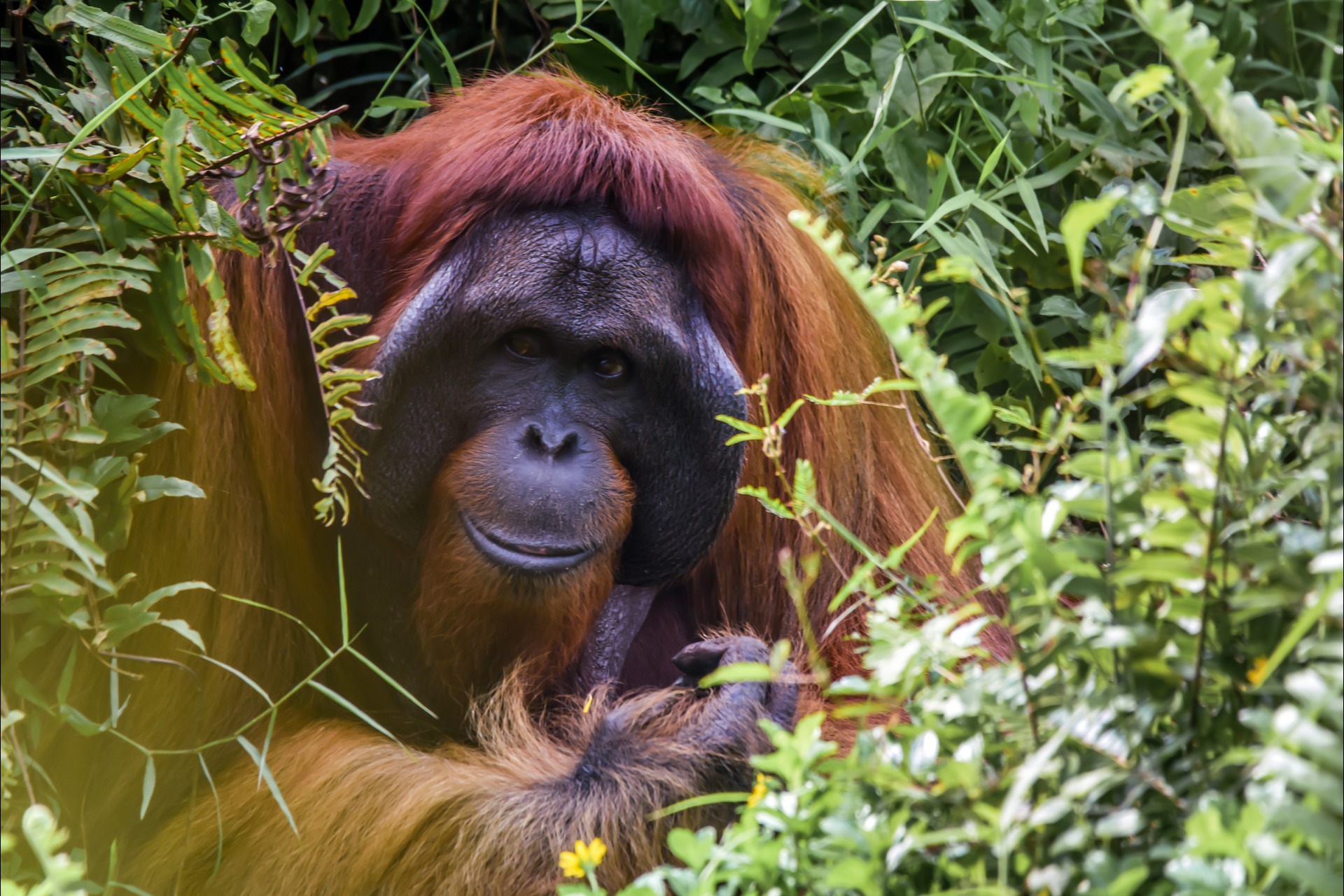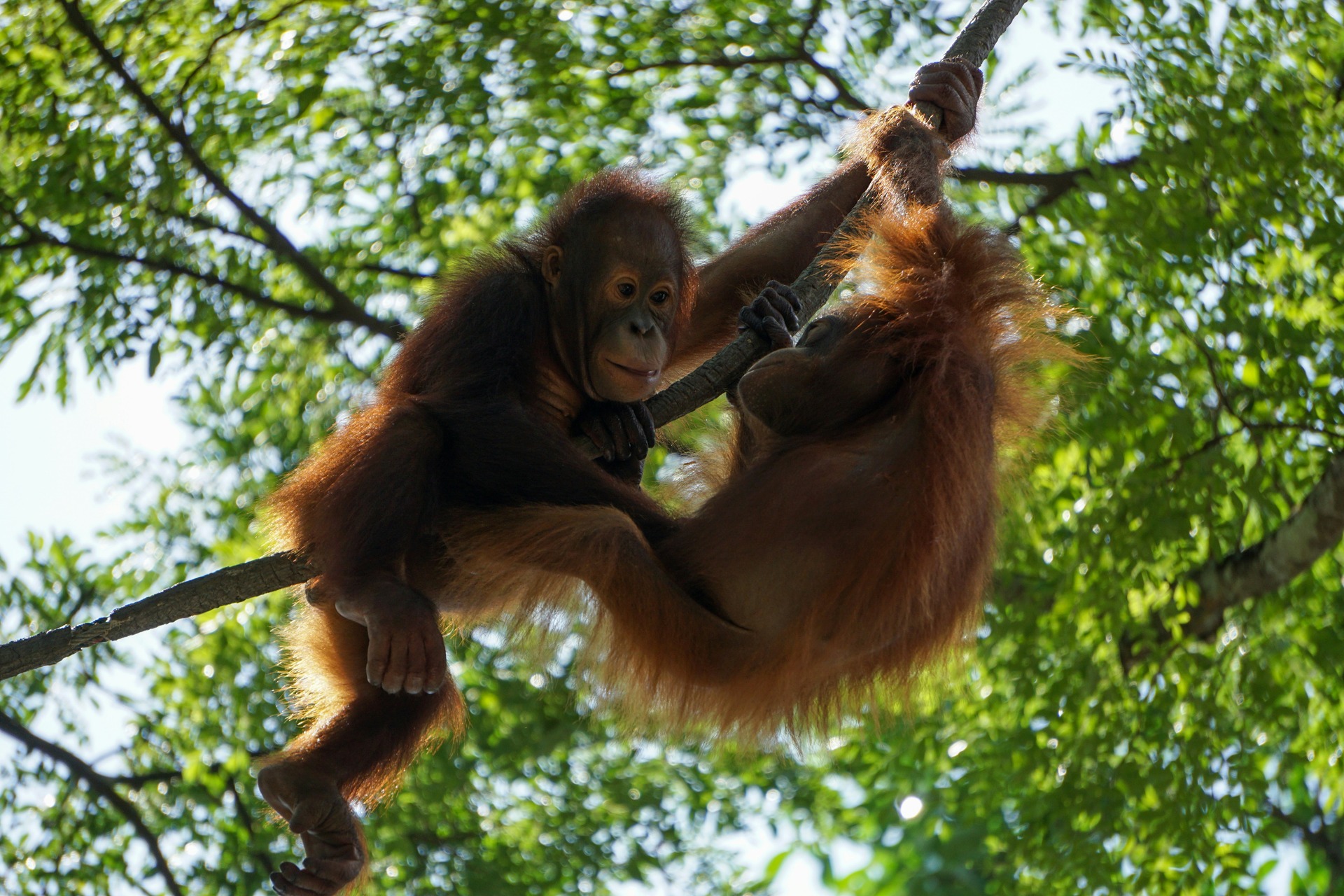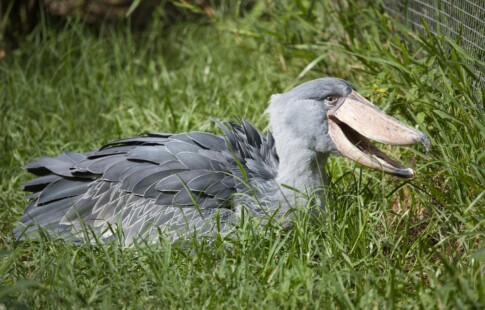
11 Interesting Facts About Orangutans
We are reader-supported. When you buy through links on our site, we may earn affiliate commission.
Orangutan, which means “person of the forest,” sets the tone for how special these great apes are. They live in the rainforests of Sumatra and Borneo and move with quiet confidence through the canopy. They also think, learn and solve problems in ways that feel familiar. Exploring their world reveals fascinating behaviors that mirror humans in surprising ways.
Orangutans are known for their distinctive red fur and gentle nature, yet there is much more to them than meets the eye. Here are 11 interesting facts about orangutans that explore their genetic makeup, unique social structure and incredible adaptations for a life spent almost entirely in the trees.
1. Orangutans Are Humans’ Close Genetic Cousins
Orangutans share around 97% of their DNA with humans — this explains their remarkable intelligence and familiar traits such as memory, problem solving and emotional depth. It also helps scientists compare health and development across great apes to guide better care for rescued and wild orangutans. This number is not a loose guess. It comes from direct comparisons of genomes and remains one of the strongest clues to humans’ close relationship with these apes.
2. They Are the Most Solitary Great Apes
Gorillas form family groups and chimpanzees live in large communities, but orangutans are different. After reaching maturity, orangutans spend most of their lives alone, and the most significant and lasting social unit is that of a mother and her dependent young.
Adult males range alone and only meet females for mating. This social pattern reflects a fruit-based lifestyle in forests where food can be patchy. Fruit trees in the rainforest are often scattered, so a solitary forager has a better chance of finding enough food than a large group would.
3. They Are the World’s Largest Tree-Dweller
Orangutans are the biggest mammals that live in trees. With arms twice the length of their bodies and grasping hands and feet, they move through branches with ease. This body plan lets them feed, rest and sleep high above the ground, where fruit grows and they are safer from threats. They are master of the canopy, spending nearly their entire lives high above the forest floor.
4. Their Diet Is Centered on Fruit
They are frugivores, meaning their diet is dominated by fruit. Orangutans are known to eat hundreds of types of fruit, though they have a particular fondness for figs and durian. They also eat leaves, flowers, bark, honey and insects when fruit is scarce.
This diet does more than fuel a large body. By swallowing fruit and passing seeds far from the parent tree, orangutans help forests renew themselves and stay diverse. Conversation groups note that seed dispersal supports hundreds of plant species and keeps the forest structure healthy over time. This is one reason that protecting their habitat protects many other animals and plants, too.

5. They Have the Slowest Reproductive Rate
Female orangutans set records for patience — they give birth only once every seven to eight years, and raise a single infant at a time. This is the longest interval between births of any land mammal. Such a slow rhythm means populations recover very slowly after losses. It also means each youngster gets long, focused care.
Because a mother invests so much time and energy into raising a single offspring, they are extremely vulnerable to threats. Their populations are unable to bounce back easily from habitat loss or illegal hunting.
6. There are Three Distinct Orangutan Species
For a long time, only two orangutan species were recognized — the Bornean Pongo pygmaeus and the Sumatran Pongo abelii. However, in 2017, scientists confirmed the existence of a third species called the Tapanuli orangutan, or Pongo tapanuliensis.
This tiny, isolated population in Sumatra is behaviorally and genetically different from the other two. However, conservation groups report that all are listed as Critically Endangered, and that the Tapanuli group likely numbers under 800. Field updates and campaigns in 2024 and 2025 keep those figures in public view and highlight the fragile state of this third species.
7. They Build a New Nest Every Day
Orangutans are highly skilled engineers and build new, intricate nests high in the trees every evening. They also make simple day nests for naps. This process involves selecting a sturdy fork in a tree and weaving branches and leaves together to create a secure platform. They often add a bed of leafy branches and even a roof if they expect rain. This skill is not innate. Young orangutans learn how to build nests by observing their mothers for many years.
8. Orangutans Have an Extremely Long Childhood
Their childhood is perhaps the longest of any animal besides humans. A youngster will stay with its mother for six to seven years, and sometimes longer. During this period, the mother teaches her offspring everything they need for survival, like how to build nests, how to move safely across branches, and where to find food.
9. Adult Orangutan Males Come in Two Forms
Flanged males carry large cheek pads and a throat sac that boosts long calls, while unflanged males are mature but lack cheek pads and look more like females. Both can father young. A study based on long-term paternity data found that flanged male orangutans have higher reproductive success at one well-studied site, supporting the idea that these alternative tactics depend on condition and context.
10. They Are Clever Tool Users and First-Aid Makers
Orangutans’ intelligence is clearly displayed in how they use tools. This behavior varies by population, which suggests it is a form of culture passed from mother to child. Orangutans have been using sticks to remove seeds and insects from tree holes. They also use large leaves as an umbrella or as a cup to drink water.
In 2024, scientists documented a wild male who chewed a plant with known medicinal uses and carefully applied the juice and leaf paste to a facial wound. The injury healed within a month. This adds to a growing record of flexible problem-solving and suggests a capacity for self-medication.
11. Their Name Is Their Identity
The name comes from Malay words “orang hutan,” which translates directly to “person of the forest.” It reflects how local cultures have long seen these apes. Modern references keep that meaning front and center to remind the public that orangutans live complex lives in ancient forests.
The Saint Louis Zoo, for example, named its 2023 baby orangutan Forest in honor of this meaning. It serves as a powerful reminder that they are not just animals but intelligent beings who are the rightful inhabitants of their rainforest homes.
Guardians of the Forest
These interesting facts about orangutans paint a picture of a profoundly intelligent, resourceful and unique species. From solitary lives to long-lasting mother-infant bonds, they truly are the people of the forest. However, knowledge of these facts comes with a heavy responsibility — orangutans are critically endangered, pushed to the brink by deforestation, mining and logging. Protecting them means protecting their rainforest homes. Their future is a reflection of humans’ willingness to preserve the wild, complex and beautiful world all living beings share.
Share on
Like what you read? Join other Environment.co readers!
Get the latest updates on our planet by subscribing to the Environment.co newsletter!
About the author

Jane Marsh
Starting from an early age, Jane Marsh loved all animals and became a budding environmentalist. Now, Jane works as the Editor-in-Chief of Environment.co where she covers topics related to climate policy, renewable energy, the food industry, and more.





